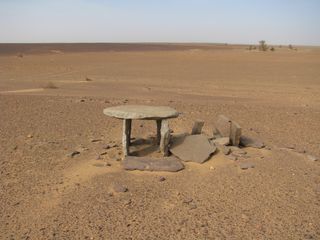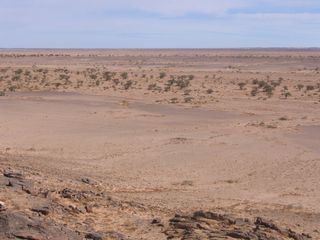In Photos: Mysterious Stone Structures in the Sahara
Mysterious structures

Archaeologists have discovered hundreds of stone structures in the Western Sahara, a territory located in Africa along the Atlantic Ocean. The structures come in various shapes and sizes, including one that curves off into the horizon (shown here). Many of the structures probably date back thousands of years. Archaeologists are not sure the purpose and exact age of many of these structures. [Read more about the Western Sahara structures]
Burial marker?

Here, a type of stone structure known as a "dolmen." It consists of one large rock on top of four others. It's possible that this dolmen marks the location of a burial.
Mysteries in the Sahara

This structure has numerous standing stones. Its purpose is also a mystery. Little excavation has been done in the Western Sahara, making it difficult to understand the purpose and precise age of the structures.
Goulets

This structure, called a "goulet" by archaeologists, has two rows of rocks that trail off into the distance. Goulets are sometimes located near other stone structures. Their purpose is unknown.
Rock piles

This large pile of rocks is called a "tumulus" by archaeologists. Researchers believe that it was likely used for a burial.
Wadi Tifariti

This image shows part of the Wadi Tifariti, a place that contains water at times during the year. While water is scarce in the Western Sahara today, archaeological and palaeoenvironmental work indicate that it was more abundant in the past.
Divided territory

About 75 percent of the territory of the Western Sahara, including most of the coastline, is controlled by Morocco, while 25 percent is controlled by the Sahrawi Arab Democratic Republic, whose territory is mostly located inland. The fieldwork was conducted in territory controlled by the Sahrawi Arab Democratic Republic.
Sign up for the Live Science daily newsletter now
Get the world’s most fascinating discoveries delivered straight to your inbox.

Owen Jarus is a regular contributor to Live Science who writes about archaeology and humans' past. He has also written for The Independent (UK), The Canadian Press (CP) and The Associated Press (AP), among others. Owen has a bachelor of arts degree from the University of Toronto and a journalism degree from Ryerson University.
